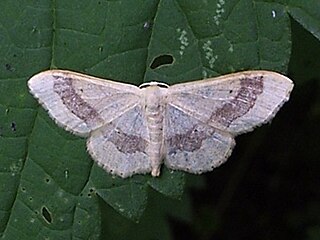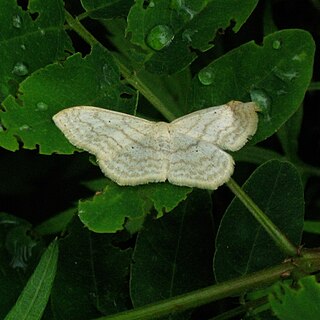
Vaccinium vitis-idaea, the lingonberry, partridgeberry, mountain cranberry or cowberry, is a small evergreen shrub in the heath family Ericaceae, that bears edible fruit. It is native to boreal forest and Arctic tundra throughout the Northern Hemisphere, from Europe and Asia to North America. Lingonberries are picked in the wild and used to accompany a variety of dishes in Northern Baltoscandia, Russia, Canada and Alaska. Commercial cultivation is undertaken in the U.S. Pacific Northwest and in many other regions of the world.

The geometer moths are moths belonging to the family Geometridae of the insect order Lepidoptera, the moths and butterflies. Their scientific name derives from the Ancient Greek geo γεω, and metron μέτρον "measure" in reference to the way their larvae, or inchworms, appear to measure the earth as they move along in a looping fashion. A very large family, it has around 23,000 species of moths described, and over 1400 species from six subfamilies indigenous to North America alone. A well-known member is the peppered moth, Biston betularia, which has been subject of numerous studies in population genetics. Several other geometer moths are notorious pests.
In Greek mythology, two sacred mountains are called Mount Ida, the "Mountain of the Goddess": Mount Ida in Crete, and Mount Ida in the ancient Troad region of western Anatolia, which was also known as the Phrygian Ida in classical antiquity and is mentioned in the Iliad of Homer and the Aeneid of Virgil. Both are associated with the mother goddess in the deepest layers of pre-Greek myth, in that Mount Ida in Anatolia was sacred to Cybele, who is sometimes called Mater Idaea, while Rhea, often identified with Cybele, put the infant Zeus to nurse with Amaltheia at Mount Ida in Crete. Thereafter, his birthplace was sacred to Zeus, the king and father of Greek gods and goddesses.

The small fan-footed wave is a moth of the family Geometridae. The species was first described by Johann Siegfried Hufnagel in 1767.

The small dusty wave is a moth of the family Geometridae first described by Franz von Paula Schrank in 1802. It is found throughout Western, Central and Northern Europe. In the north, its range extends as far as Denmark and southern Scandinavia. In the east its range extends as far as Russia. Idaea seriata is replaced by the subspecies Idaea seriata canteneraria, from the north-east of Spain and the central and eastern Mediterranean to the Crimean peninsula, while the western Mediterranean and the Balearic Islands are inhabited by the sister species Idaea minuscularia. Outside Europe it is found in eastern Algeria, Tunisia, Turkey, Cyprus, the Caucasus and the northwest of Transcaucasia. In Morocco and western Algeria, it is replaced by the sister species Idaea minuscularia. In the British Isles it is common in England and Wales but is only found in the eastern half of Scotland and it is rare in Ireland.

The riband wave is a moth of the family Geometridae. The species was first described by Carl Linnaeus in his 1758 10th edition of Systema Naturae.

Idaea, sometimes called Hyriogona, is a large genus of geometer moths. It was erected by Georg Friedrich Treitschke in 1825. They are found nearly worldwide, with many native to the Mediterranean, the African savannas, and the deserts of western Asia.

Idaea emarginata, the small scallop, is a moth of the family Geometridae. It was first described by Carl Linnaeus in his 1758 10th edition of Systema Naturae and it is found in Europe.

Idaea filicata is a moth of the family Geometridae. It is found in Southern Europe and the Near East.

Idaea inquinata, the rusty wave, is a moth of the family Geometridae. It is found in Europe.

Idaea straminata, the plain wave, is a moth of the family Geometridae. It is found in Europe including West Russia and Balkans.

Idaea humiliata, the Isle of Wight wave, is a moth of the family Geometridae. It is found in Europe. This species was found on the Isle of Wight but became extinct around 1931. There was one sighting in Portsmouth in 1954 but the moth appears to be currently extinct in the United Kingdom.

Idaea sylvestraria, the dotted border wave, is a moth of the family Geometridae. The species was first described by Jacob Hübner in 1799. It is found in Europe.

Idaea laevigata, the strange wave, is a moth of the family Geometridae. It is found in Central Europe and Southern Europe. It occurs in Britain as an imported species.

Idaea serpentata, the ochraceous wave, is a moth of the family Geometridae. The species was first described by Johann Siegfried Hufnagel in 1767. It is found in most of continental Europe and the Near East.

Idaea infirmaria is a moth of the family Geometridae. It is found in Southern Europe.

Idaea flaveolaria is a moth of the family Geometridae first described by Jacob Hübner in 1809.

Idaea tacturata, the dot-lined wave moth, is a moth of the family Geometridae. The species was first described by Francis Walker in 1861. It is found in the US from Virginia to Florida, west to south-eastern coastal Texas.

Idaea eugeniata is a moth in the family Geometridae. It is found in Italy, France, Andorra, Spain, Portugal and North Africa.

Idaea furciferata, the notch-winged wave moth, is a moth in the family Geometridae. It is found in North America, where it has been recorded from Maryland to northern Florida, west to Missouri and Texas.


















